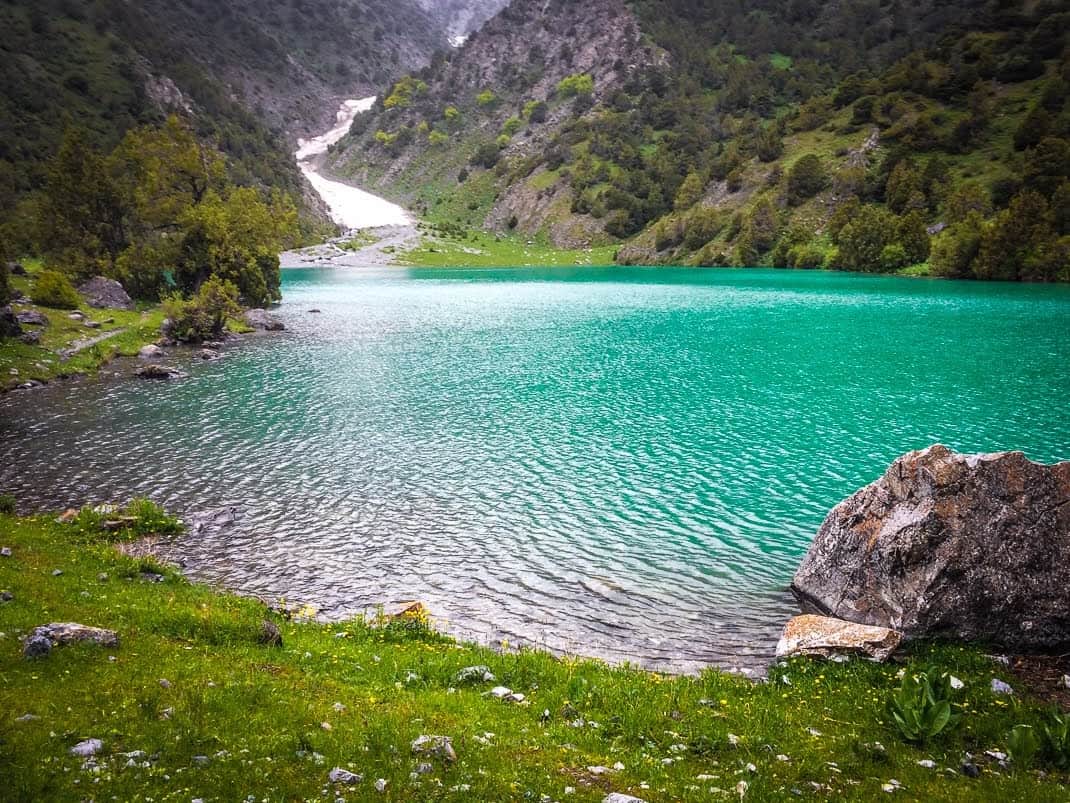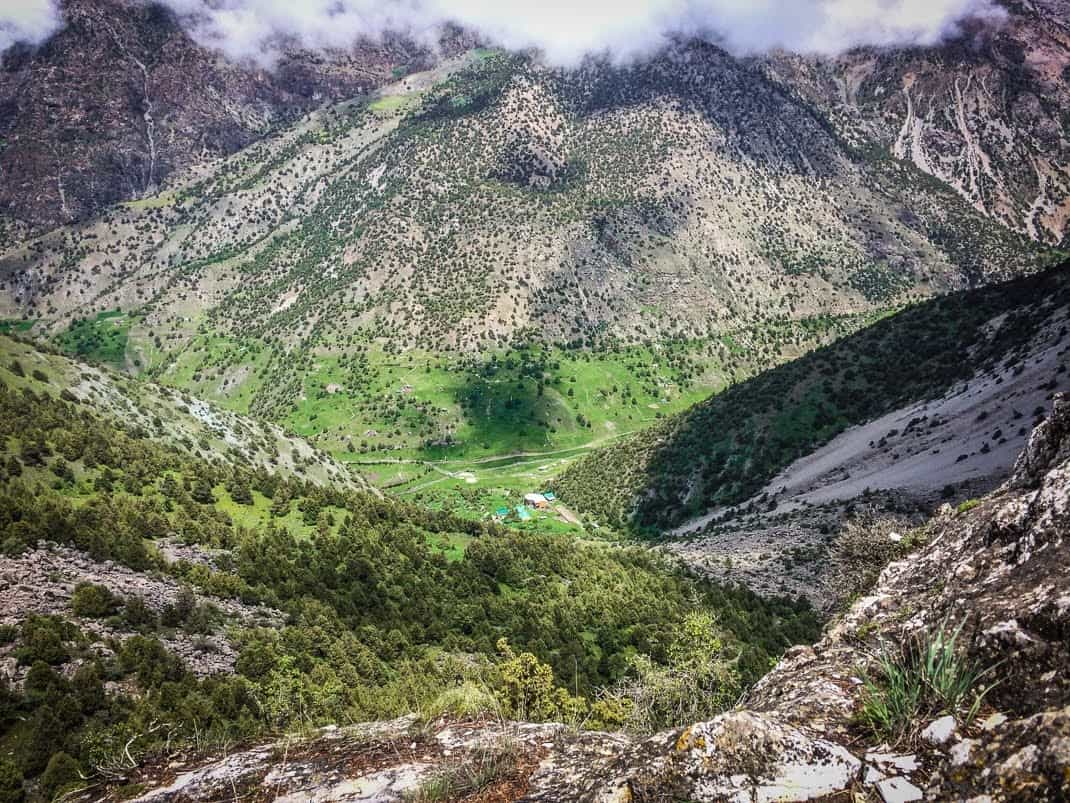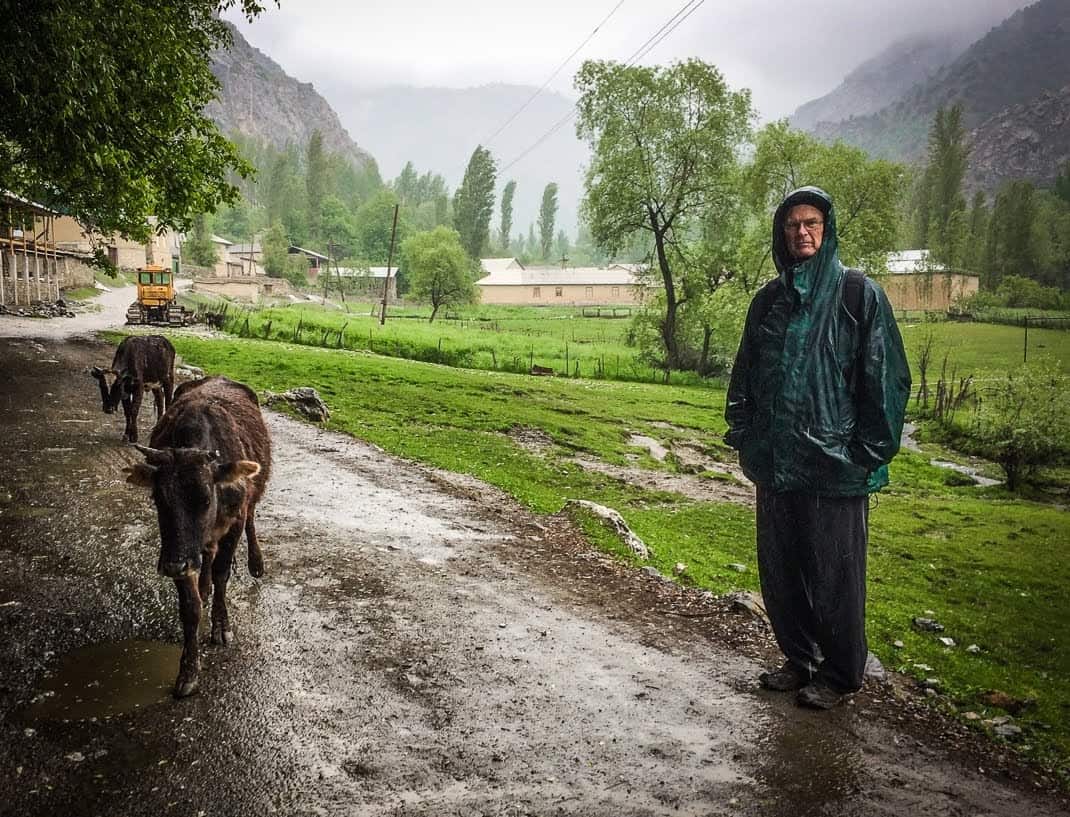
Hiking in Tajikistan: Getting There is nearly as Difficult as the Hike
By John Henderson

I stood at the bottom of the mountain and tried to see the top in vain. When I climb a mountain and can’t see the top, I know this will be one monstrous trail. Here I had one more problem.
I couldn’t see a trail.
We were hiking in Tajikistan. The vertical grade was about 75 percent and the hill looked virgin. On one side lay loose shale; on the other stood bushes. Who has ever climbed this mountain, billy goats?

“Take your time. We’re in no hurry,” said Bahodur Rahmatilloev, my 19-year-old Tajikistan guide whom I include in the category of billy goats.
He nearly skipped up the debris shepherding me along, showing patience with my frequent pit stops.
I’ve hiked all over the world, from the Andes to the Himalayas to scaling Mt. Kilimanjaro in between.
Few places I’ve been match the raw, unspoiled beauty and occasional heart-sapping difficulty of where I then stood, staring up into impossible terrain.
Tajikistan. The Poorest Soviet Republic
The poorest republic in the Soviet Union remains the poorest republic from the old Soviet Union. What it lacks in a gross national product it makes up for in a natural national product.
This is a country where 90 percent of the country is upland, where mountains stretch from the far western region jutting into Uzbekistan to the Pamirs in the southeast where Marco Polo once followed the Silk Road.
Tajikistan is part of the Stans, the oft-misunderstood set of Islamic countries covering much of Asia’s mountainous underbelly. “Stan” in Persian stands for “state.” It does not stand for “terrorism.”
After 67 years of Soviet rule, Tajikistan knows terrorism. Following independence in 1991, a civil war ignited by the election of the old communist guard resulted in ethnic cleansing and 60,000 deaths.

Tajikistan emerged from the bloodshed to become an outdoor wonderland still in its infancy as a tourist destination.
The spiffed-up capital of Dushanbe (pop. 680,000) has the most beautiful collection of monuments and architecture of any former Iron Curtain country I’ve visited besides Prague.
Impossibly romantic Rudaki Park features towering statues of Ismoil Somoni, the hero who founded the Samanid dynasty which ruled here in the 10th century, and of Rudaki, Tajikistan’s most famous writer from the 9th century, all in a setting of endless roses and bursting fountains.
Mountains the Main Draw
But in a country where the amount of flat land could fit inside the borders of Connecticut, the main draw is the mountains. I was in the middle of the Fan Mountains, a string of jagged peaks enveloped in juniper trees with every snow-covered mountain seemingly accompanied by its own emerald lake.

Getting here is nearly as difficult as hiking here. I took a shared taxi (a four-door car that waits to get filled before leaving, departure times be damned) five hours from Dushanbe to Penjikent, an ancient Silk Road town that inspires images of North Africa with its teeming central market and women in headscarves.
The next morning I rode in a badly needed four-wheel drive for 2 ½ hours over boulder fields, mud holes, and rapids just past the mountain village of Artuch. Hiking Tajikistan is not for the faint of heart.
Artuch Mountaineering Camp
I based myself in the Artuch Mountaineering and Tourist Camp, built by the Soviets in 1971 for mountain climbers and hikers from around the Iron Curtain. It hasn’t changed much. Neither has the setting.
The camp consists of the main lodge of shared rooms over a big dining area and some spruced-up cottages with heat and a modern shower. My cottage featured a carpeted prayer room for Muslims.

Yes, Tajikistan is your prototype off-the-beaten-path destination. In fact, it’s so off the beaten path there is no path.
That’s the dilemma I faced as I stared up at Bahodur standing about 30 feet above me in a sea of loose shale, waiting for me to catch up. Bahodur is a bright, fit, witty university student whose father operates a driver’s school in Penjikent.
On a nickel city tour, Bahodur proudly showed off his dad’s instructional lot, complete with bright lane markers and stop signs.
It was by far the nicest road I saw in Tajikistan.
We were on Mt. Chuarek, at 3,300 meters one of the smaller mountains in the Fan range. But few are steeper. I kept climbing up the shale and kept slipping. Two steps up, one back.

“This is impossible!” I said. “I can’t climb this!”
“I think we should go this way,” he said.
He pointed to some greenery to the left. It was a collection of bushes and grasses that went all the way up alongside the shale. I saw no path, let alone a directional sign.
I slowly made my way up, grabbing branches, finding purchase in the few spots of clear land. It was as steep as the final ascent of Kilimanjaro yet every time I looked behind me I got inspired.
Below me were the two beautiful, emerald lakes we passed, both looking like droplets of melted snow under the mountains above.
I kept going.
When I reached the top, I gave Bahodur a soul shake from the ‘70s and looked out. I was at eye level with numerous snow-capped mountains in the range and the two lakes glistened in the sunlight below. I looked down the other side and saw some tiny structures in the valley.
“What’s that?” I asked.
“That’s our camp,” Bahodur said, smiling.

I hiked for four straight days around Artuch and with the number of mountains and lakes nearby I could’ve hiked every day for another week. An even more popular spot in the Fan Mountains is Haft-Kol. “Seven Lakes” in Tajik, they’re a string of seven idyllic lakes all dotted with cheap homestays about 15 miles west of Artuch. A landslide, however, wiped out the road and Artuch was my best option.

Each Hike Was Beautiful
I didn’t complain. Each hike was different and beautiful in its own realm. Our first day we hiked through a gentle mist up from camp to the three lakes below Chuarek, each one a little higher than the next. All three were green and clear as bathwater. A small, narrow glacier ran down a rivet between two mountains.

Off to the side, Bahodur pointed out an underground spring, bubbling the water near the bank. I dipped my hand in. It was ice cold. Bahodur said he swam here once.
Once.
We didn’t see another soul for three hours. Nothing could be heard but the squawk of birds. I suddenly didn’t feel the rain. I wasn’t cold at all.
The next day we woke to dense fog and rain. We couldn’t see the foot of a mountain, let alone a peak. It was a good day to explore the village of Artuch. However, we underestimated the distance. It was 10 kilometers — downhill — from our camp, meaning we had to return uphill, through the rain and mud and over a troublesome river.
It was a 5 ½-hour slog but the village provided a slice of rural Tajik life you won’t read about in Lonely Planet. Children on burros followed us down the path. We passed women in traditional black tunics.
Claptrap Houses
Artuch has about 2,500 people spread over a kilometer along the crude service road. Claptrap wood and cement houses sit on narrow dirt roads above the river.
The people wore surprisingly bright, decorative tunics as if going to a traditional dance. Instead, they were dressed for a memorial service.

“A little girl died today,” Bahodur said.
We saved our final day for the featured hike in the area. Kulikalon means “big lake” in Tajik and the biggest of three alpine lakes linked by cascading streams is indeed big.

It’s a 2 ½-hour climb over one hill after another. But on a sunny, 70-degree day, the scenery gave my rapidly weakening legs a second wind.
When we finally reached a grassy plateau, we saw Kulikalon.
It lived up to its billing. Big and green and clear, it stretched for hundreds of meters in front of me and beyond, reaching to the edge of massive, snow-capped mountains forming a perfect white, wintery background.
I stood on a rock at the lake’s edge, stretched my arms out, like, yes, this is what life is about.
This is traveling. This is getting to the back of beyond.
Bahodur was disappointed.
“It’s much more beautiful in the summer,” he said. “The snows haven’t melted yet. I’m sorry.”
No need to apologize, my friend. Tajikistan has no need, either. Through a generation of oppression, chaos and bloodshed, the Soviet Union’s poorest republic is rich in so many other ways.
- Tropea: The Gem of Calabria - July 20, 2023
- Istanbul’s Fascinating Hippie Travelers’ Pudding Shop - May 20, 2023
- Malta is Popular for Making Movies - September 2, 2022






Amazing one. What not to like there, the mountain, lake and food.. This will be one hell of the journey. I have always been an travel enthusiast and I am in Nepal right now. You can check my blog here.